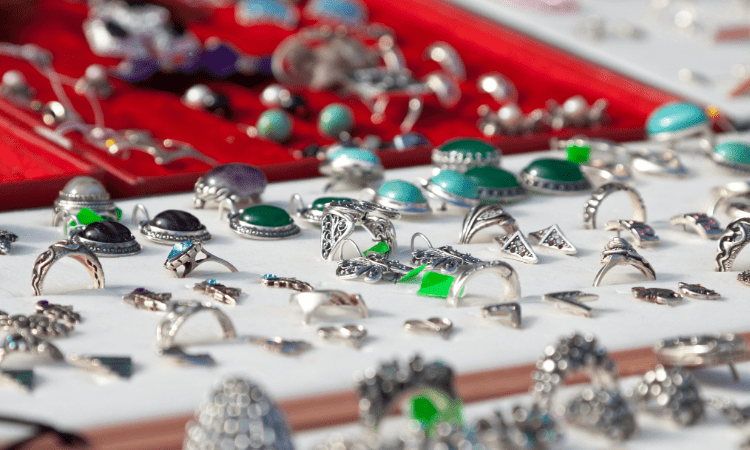Accessory Tests

Test Requirements for Accessories
Accessories are products that play a major role in the fashion world, providing aesthetics and functionality. However, regardless of their aesthetic value, the safety of these products is also extremely important. In particular, consumer products such as jewelry, watches and bags should not contain harmful substances that could threaten the health and safety of the wearer, as they come into direct contact with the skin and are often carried in daily use. That's why manufacturers of accessories and other consumer products must fulfill various testing requirements and comply with certain regulations to prove that their products are safe.
In this blog post, you can find important information on why testing requirements, methods, regulations and analysis services are critical for accessories and consumer products.
Accessory Safety Test Requirements:
Accessories can carry serious health risks due to the materials and chemicals they contain. Compliance with national and international standards is essential to minimize these risks and provide consumers with safe products.
Most consumer products are treated with various chemicals during the manufacturing process. These substances can cause health problems when they come into contact with the skin or are used for long periods of time. Chemicals for which consumer products, including accessories, should be tested include:
- Heavy Metals: Heavy metals such as lead, cadmium, arsenic and mercury can be found in the materials used in the production of accessories. Excessive amounts of these metals can cause serious health problems such as cancer. Regulations such as REACH and RoHS prohibit the use of these substances above certain limits.
- Phthalates: Phthalates are widely used in plastic materials and are particularly harmful in children's products. Phthalates can have negative effects on hormonal disorders and reproductive health. Certifications such as CPSIA and OEKO-TEX limit the phthalate content.
- Azo Dyes: Azo dyes are widely used in textiles and leather products. However, some azo dyes can be carcinogenic when in contact with skin. Therefore, azo dyes should also be tested during chemical analysis of accessories.
- Flammability Tests:Accessories sometimes contain flammable materials. Performing flammability tests on such products is a critical requirement for safety. Products should be manufactured with fire-resistant materials and should not have a flammable label.
Regulations and Standards
The safety of accessories and other consumer products requires compliance with certain regulations and international standards. Here are some of the most important standards and regulations:
1. REACH (Registration, Evaluation, Authorization and Restriction of Chemicals)REACH is a regulation issued by the European Union and imposes strict controls on the production, distribution and use of chemicals. KKDIK is the Turkish equivalent of the REACH regulation and entered into force in 2017. KKDIK regulates the Registration, Evaluation, Authorization and Restriction of Chemical Substances. This law sets out all responsibilities for the management of chemicals in Turkey and has a similar structure to REACH. REACH prohibits chemical substances above certain limits, especially those used in accessories and other consumer products. Harmful substances such as heavy metals, phthalates and azob dyes are strictly regulated under REACH.
2. CPSIA (Consumer Product Safety Improvement Act)CPSIA sets out the safety laws that apply to children's products in the United States. Harmful substances such as lead, cadmium and phthalates are prohibited in children's products such as accessories. These products must be safety tested and CPSIA certified.
3. OEKO-TEX® Standard 100OEKO-TEX® Standard 100 is a certification that monitors the safety of chemicals in textiles. Accessories must have this certificate, especially for products made with textile and leather materials. It is clearly stated in this standard that substances such as azo dyes and formaldehyde should not exceed the limits.
4. RoHS (Restriction of Hazardous Substances)RoHS is a European regulation that limits the use of harmful substances in electrical and electronic products. Compliance with these regulations is required for accessories with electronic components (e.g. watches, smart jewelry). Substances such as lead, cadmium and mercury are banned under the RoHS regulation.
Testing and Analysis Services for Accessories and Consumer Products
Accessories and other consumer products are not only made safe, but also legally compliant by undergoing the above-mentioned tests. NanoLab offers comprehensive testing services to ensure the safety of accessories and consumer products.
Why Nanolab?
Nanolab Laboratories Group provides testing services and compliance with legal regulations for both manufacturers and consumers, ensuring the safety and sustainability of products. NanoLab is an important testing partner that ensures that products are safe and legal by performing these tests with the highest accuracy. You can contact Nanolab for the right testing services, not only for consumer health and safety, but also to protect the reputation of brands.

